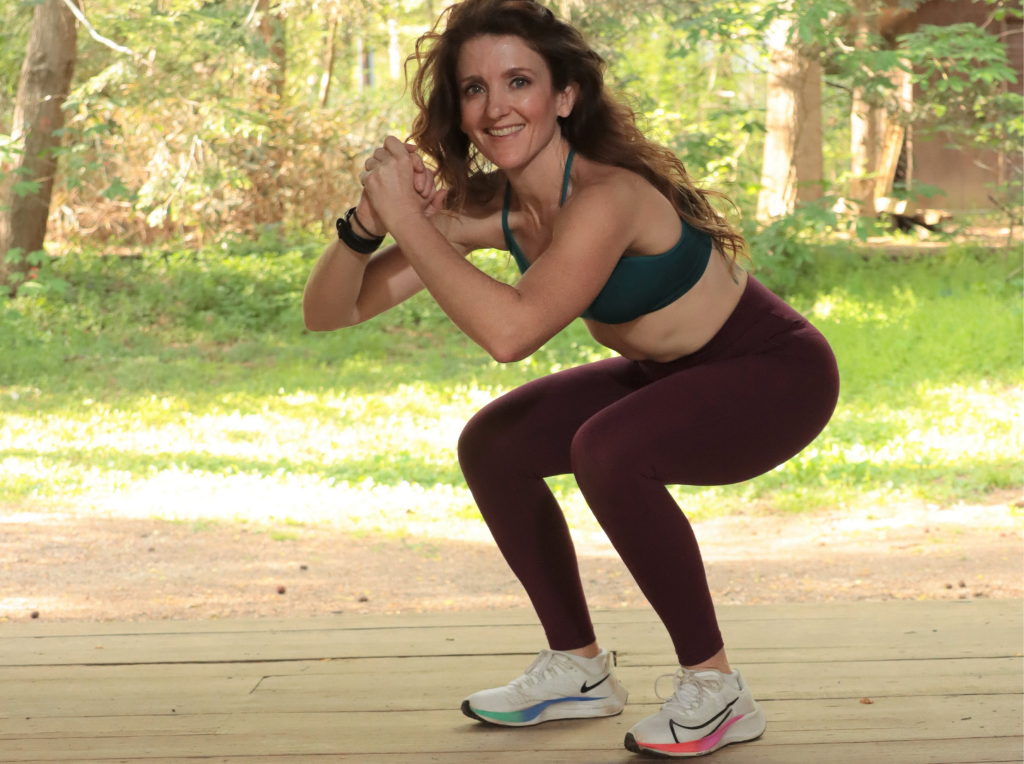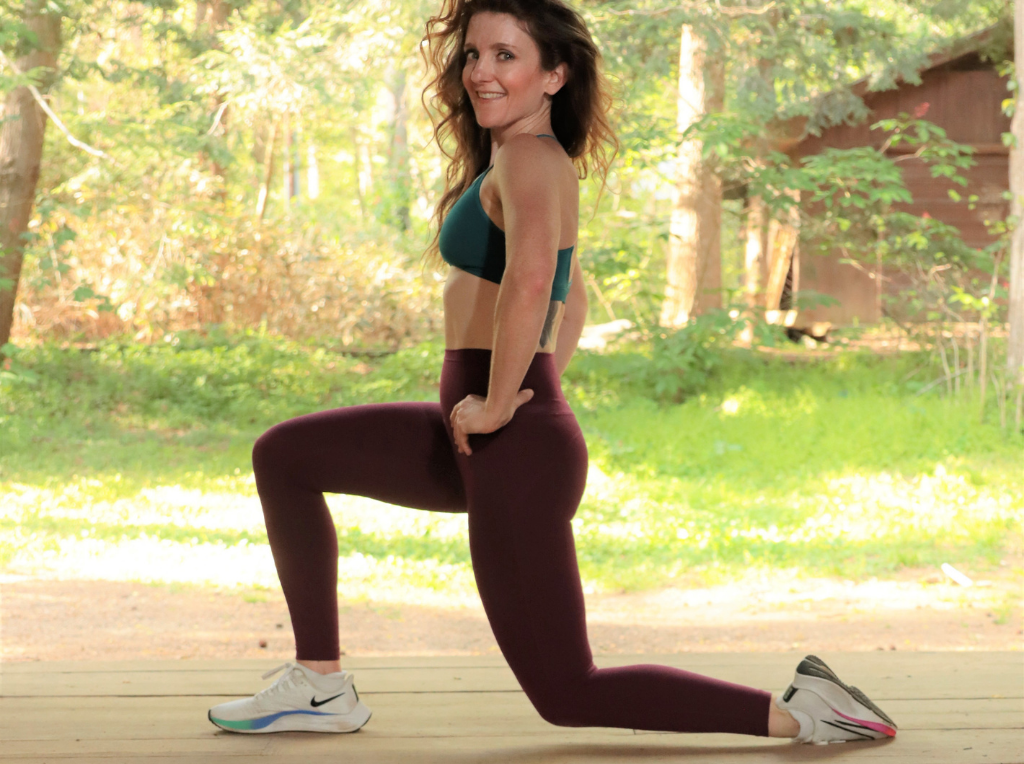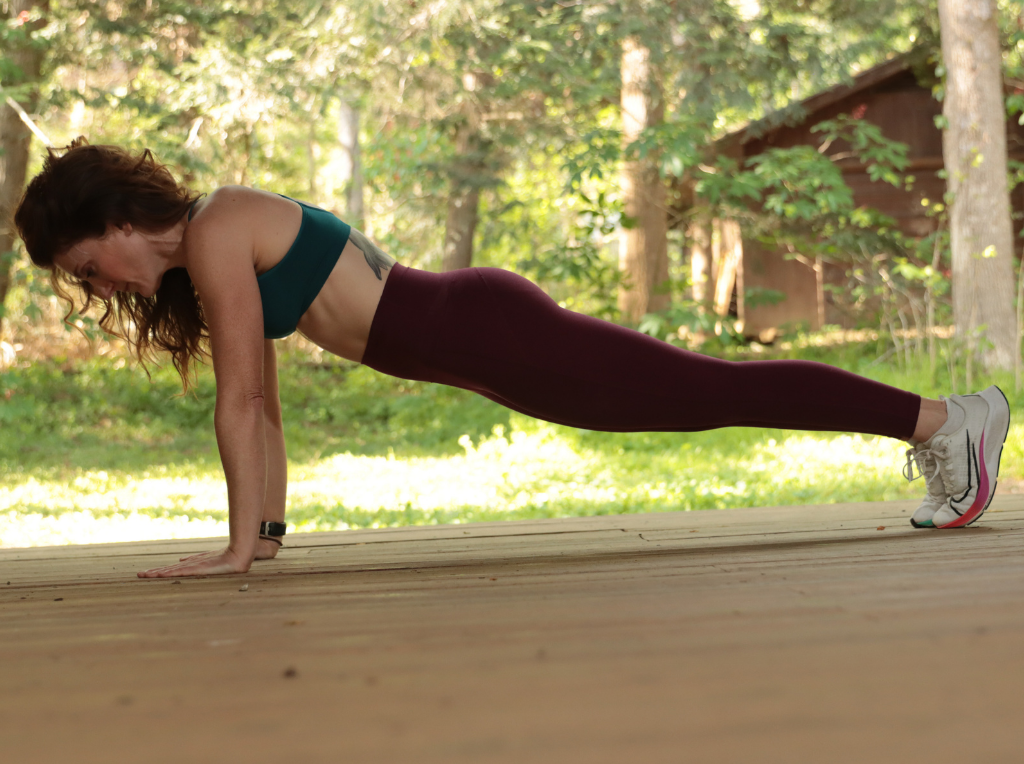Strength training for runners doesn’t have to take a lot of time. And the results are worth the investment!
If you want to become a better runner, the first place to start is to run a little bit more. That could mean lengthening your runs or adding in another day per week. But there will come a point where you simply can’t (and shouldn’t!) run more.
And that’s where strength training comes in.
Why Runners Should Strength Train
The two main benefits of strength training for runners are that it prevents and helps heal injuries, and it enhances performance. Done properly, strength training creates a foundation for injury-free running and allows you to keep up with increasing mileage and intensity on your runs.
And on the performance side, studies have shown that resistance training improves running economy and endurance muscle fibers. Research has also linked weight training to better body composition and resting metabolic rates.
Not to mention, strength training is particularly important as we get older, in a way that running alone is not. Recent studies have proven that running does not protect against the gradual loss of lean muscle tissue and, as we lose muscle, we also lose a larger percentage of our fast-twitch muscle fibers, which is part of why we slow down as we age.
To say it another way, if you are afraid of getting slower as you get older, making strength training a part of your routine will slow down that slow down.
Well, to be clear, endurance runners do not need to be super strong and muscular. Just take a look at the difference between a 100m sprinter’s body and an elite marathoner. The sprinter will be visibly muscular and the marathoner will be much more lean. That’s because sprinting requires huge explosive power from big muscles while endurance runners simply need to be strong enough to endure mile after mile.

The good news is that if you are an endurance runner, you don’t have to spend as much time lifting weights as a sprinter would. And you don’t have to attack your strength sessions with the same amount of discipline and focus as you do your speed days on the track.
The thing to remember is that if running is your primary focus, your strength work should complement your running, not compete with it.
When to Strength Train
The timing of your gym sessions is important. If you are lifting twice a week, you do not want to be doing that on your easy days. Easy days are meant for recovery from your harder runs, not for additional muscle damage from lifting weights, even if you are lifting light. The absolute best way to complement your running is to lift on the same day as your hardest runs.
For example, if you have a tempo run in the morning, follow it by a 20- to 30-minute strength workout at noon or in the evening. That way, you are adding to the training effect of the running, then you fully recover from both on the following easy days.
Running hard then hitting the gym also helps you avoid muscle soreness that can cause your running to suffer. If you go too hard with the weights then try to run hard, it’s not going to go as well as when you are fresh.
But I also get that most people don’t have unlimited time to exercise and two workouts on the same day isn’t always possible. And if you don’t particularly love strength training, getting in a big session is going to be even harder.
So don’t be afraid to break it up into smaller sessions per week.
How Much You Need
Most long-distance runners only need to strength train about 30-60 minutes a week. That can be ten minutes a day or two days of 20-30 minutes a week. A little really does go a long way, but once a week is probably not often enough.
If a longer workout isn’t for you, try adding 10 to 15 minutes after each run. Lift slowly with heavy weights and you’ll be amazed at how much work you can get in. Now, if you have a tough speed session the next day, you might want to go easy on the leg work and do some upper body exercises instead.
The Best Exercises For Runners
A great place to start is with four exercises that can be done anywhere. You can do them with just your body weight or with dumbbells and there are plenty of variations to keep things interesting
The four best exercises for runners are: squats, deadlifts, lunges, and planks. Let’s break each of those down.
Squats

In a standard bodyweight squat, you are targeting your quads, hamstrings, glutes, abdominals, and calves, which are all essential to good running. You can add variation by lifting one heel to weight one leg more than the other, you can open your stance and target your inner thighs and do a sumo squat, or you can add a jump to make the move more powerful.
Deadlifts
A deadlift is another compound exercise where traditionally, a weighted barbell starts on the floor. Since you lift it with no momentum, you are lifting “dead weight,” which gives the exercise its name.
Deadlifts train multiple muscle groups including the hamstrings, glutes, back, hips, and core.
When it comes to strength training, some people believe that you should really focus on your legs, because that’s what you use for running. Other people think you can go light on the legs, because running strengthens those, so you should focus on the core. And many runners simply have no idea what to do with their arms.
Research on runners makes it clear that upper-body, lower-body and core strength training all contribute to improved running performance. So yeah, that’s just about everything. You should do exercises that involve all of the major muscle groups, because that helps create balance as everything is connected.
A slightly different variation is the Romanian deadlift which focuses more on the hamstrings. You start with a bar or a set of dumbbells at your hip level with your palms facing down. Keep the weights close to your body as you lower it toward your feet, pushing your hips back throughout the movement. Your legs should have a slight bend in the knees. Drive your hips forward to stand up tall, keeping the barbell in front of the thighs.
Lunges

Lunges also work the quads, glutes, hamstrings, and calves as well as other supporting leg muscles, depending on the angle you perform them on. Forwards, backwards, laterally, or adding a torso twist, are all great variations.
Plank

The last of my 4 favorite strength training for runners moves is the plank. Planks are amazing because they truly are a full body exercise with plenty of ways to mix them up. To do them right, keep your core engaged, maintain a neutral spine, and be sure to breathe.
For a follow-along five minute strength session, check out this video and post!
Now, just because I love those four exercises as well as their million variations, it doesn’t mean you are limited to just those, but they are a great foundation. Moving your muscles against resistance can be achieved with your body weight, a resistance band, a machine or with free weights–your muscles don’t know the difference.
Although, I would argue that machines at the gym do take away the work of the stabilizing muscles so you get less bang for your strength training buck. For example, if you sit down and do the leg press, there is no need to counterbalance or engage your core. And that means, you’ll have to do another exercise to target the core.
Now when I say core, do you automatically think sit ups and crunches? Those are great if your goal is to look strong, but to actually get a strong core, there’s a much better way. And that’s unilateral training.
Unilateral Training
Unilateral training is lifting a weight on only one side of the body at a time. Lunges are unilateral because you are doing one leg at a time. Standard squats, where both legs are planted equally on the floor, are bilateral.
When you lift on one side of the body, your core is forced to engage to keep you from falling over. So by lifting unilaterally, you are getting in the core stabilizing work runners need, without doing a single sit up.
Lift Slow and Heavy
Alright, so you’ve chosen what to lift, but how heavy and how many reps? Actually, the number of repetitions is not critically important. The gym is not where you work on your endurance. You do that on the run. Recent research has shown that doing five reps or 20 reps will produce the same benefit in terms of muscle strength and endurance. That’s important for busy runners. .
Some runners believe that they should only do bodyweight work because it’s easier and runners don’t really need to bulk up. Well, just because it’s body weight, doesn’t mean it’s easy! Pull ups, for example, are extremely challenging for most people, even though it’s just bodyweight.
What’s more important than the number of times you lift a weight, is how you lift them. It’s far more effective to lift and lower the weight slowly. Take two to three seconds to lift the weight and at least three seconds to lower the weight, pausing at the hardest point for a second before you lift again.
The reason for the slow lift is you want to eliminate momentum. Momentum cheats your muscles because the swing is doing the work for you. In addition, the faster you move, the greater the force on your joints and connective tissue, which means greater the risk for injury. Lifting weights too quickly is far tougher on the joints than lifting too heavy.
Power Boost at the End
If you are looking for a power boost, save your explosive effort for the end of each set of exercises, when you are getting fatigued. Fast movement will be impossible at this point, which protects you from its risks. But from a muscle fiber recruitment standpoint, it still is fast-twitch training. This type of strength training for runners is safer than plyometric exercises and produces the same powerful effects.
You’ll want to lift a weight heavy enough to fatigue the muscle you are working somewhere in eight to 20 reps. You’ll know when to stop when it is impossible to complete one more with perfect form. This ensures that the muscle fiber is being completely recruited each and every lift.
Save Time With Fewer Heavier Reps
Let’s do a little math:
So if you are taking 3 seconds to lift a weight, 3 seconds to lower, with pause in the middle, that’s 7 seconds per rep. If you choose a weight heavy enough to exhaust you in 8 reps, that’s 56 seconds per muscle group. If you divide the body into 5 major muscle groups (1. chest, 2. back, 3. arms and shoulders, 4. abdominals or core, and 5. legs and glutes), that means you can work every part of your body in about 5 minutes. Add in some time to rest between sets, and you’re done in 10 minutes.
If you’ve got more time and prefer lifting lighter weights with more reps, by all means go for it, but remember you are not running and don’t want to turn your gym session into anything aerobic. A better use of your time would be adding in different exercises. So instead of doing 20 hamstring curls, for example, do just ten to fatigue, and then do ten heavy calf raises to fatigue.
Consistency Over Intensity
When in doubt, less is more when it comes to strength training for runners, as long as you consistently do it a few times a week.
So there you have it. A little strength training for runners, a few days a week, mainly after your harder runs, with compound exercises like squats, lunges, deadlifts, and planks, is the magic formula. Well, it’s not magic, but it’s an investment.
An investment that will pay off by making you a more durable, faster runner, not to mention slow the effects of aging.
Squats, anyone?

